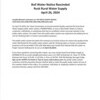Navigating Recovery for Texans after severe winter storms

FEMA’s Individual Assistance Program (IA) provides financial assistance and direct services to eligible individuals and households who have uninsured and underinsured necessary expenses and serious needs.
The IA program is not a substitute for insurance and cannot pay for all losses caused by a disaster. By law, FEMA cannot duplicate benefits.
IA is intended to meet basic needs and help survivors get back on their feet. FEMA is not empowered to make you whole.
Homeowner’s Insurance
Insurance is designed to protect your major investments and your home. It is one of your most significant investments.
Fortunately, insurance provides you more financial security than disaster assistance grants.
Following the storms, many homeowners and renters experienced power outages, extreme temperatures and damage that occurred from burst pipes in their homes.
Typically, homeowner’s insurance covers repairs and damage associated with burst pipes.
After Applying to FEMA for Assistance
When applicants apply to FEMA for assistance, they are asked if they are insured.
Insurance is then taken into consideration as their application is processed if they indicated they had insurance.
By law, FEMA cannot reimburse for losses covered by insurance, so their applications will require documentation of their insurance settlement or denial.
FEMA Determination
Applicants will receive a letter or notification indicating the status of their application.
For many applicants with insurance, the letter will indicate “No Decision.” This is NOT a denial. It is stating that additional information is required to continue processing the claim, which is often a copy of their insurance settlement or denial.
Some applicants may receive notification that they are “Ineligible” for FEMA assistance. In this disaster, some of the reasons for this determination is the need to provide proof of ownership or occupancy. Examples of documentation to prove ownership can include:
Mortgage Statement
Property Tax Receipt or Bill
Examples of documentation to prove occupancy can include:
Utility Bills
Lease/Housing Agreement
Rent Receipts
That is why FEMA asks applicants to read the letter carefully to identify if any documents may be missing.
How to Respond if Documents are Missing
Applicants can upload additional documents from their insurance provider to meet the requirements identified in the determination letter by following a few simple steps.
Additional documentation can be uploaded to DisasterAssistance.gov or by calling the FEMA helpline at 800-621-3362.
The best, and fastest, way to send disaster documents to FEMA is to upload your documents online. It takes just six easy steps:
Step 1: Visit DisasterAssistance.gov
Step 2: Select check status
Step 3: Login or create your online account
Step 4: Select the correspondence tab
Step 5: Select upload center
Step 6: Follow the online instructions
Virtual Home Inspections
Because of the nature of these storms, the damage to homes is likely on the inside of the dwelling and not the outside.
Inspections are issued when a disaster-related need is initially identified based on the registration questions. Fortunately, most homeowner’s, mobile home and renter/owner’s content insurance may cover damage incurred by ice and snow.
-----
Winter Storm Damage? Here is What FEMA Assistance May Cover
DR-4586-TX / FS 001
Texans with uninsured losses should apply for FEMA Individual Assistance as soon as possible. Residents whose homes are insured should file their insurance claims prior to applying with FEMA.
FEMA Registration Guidance for Texas Storm Survivors
The fastest and easiest way to apply is at www.disasterassistance.gov and then selecting “Apply Online.” During the application process, please ensure to select the cause of damage as snow/ice. If you have insurance and are applying for disaster assistance, you must file a claim with your insurance company as soon as possible. By law, FEMA cannot duplicate benefits for losses covered by insurance. If insurance does not cover all your damage, you may be eligible for federal assistance.
FEMA’s Individual and Household Assistance program is not a substitute for insurance and may not pay for all losses caused by a disaster.
If it is not possible to register online, call 800-621-3362 (TTY 800-462-7585). The toll-free telephone lines operate from 6 a.m. to 10 p.m. CDT daily. Those who use a relay service such as a videophone, Innocaption or CapTel should update FEMA with their specific number assigned to that service.
When you apply for assistance, have the following information readily available:
A current phone number where you can be contacted.
Your address at the time of the disaster and the address where you are now staying.
Your Social Security number, if available.
A general list of damage and losses, and
If insured, the insurance policy number, and the agent or company name
Disaster Assistance and Eligibility
Disaster assistance may include financial assistance for temporary lodging and home repairs, low-interest loans from the Small Business Administration (SBA) to cover uninsured property losses, and other programs to help individuals and business owners recover from the effects of the disaster.
For eligible homeowners and renters in a designated county, FEMA assistance may include:
Property: FEMA may assist with the repair of damage related to burst pipes as well as disaster-damaged heating, ventilating, and air-conditioning systems, refrigerators and stoves.
Other possible repairs that may be covered include:
Disaster-related damage to electrical, plumbing or gas in the home.
Leaks in a roof that damage ceilings and threaten electrical components.
Disaster-damaged subfloor in essential occupied parts of the home, and
Disaster-related broken windows.
Lodging Expense Reimbursement: DR-4586-TX only. Survivors who incurred uninsured lodging expenses due to utility outages only and did not have disaster-related damage to their home may now be eligible for reimbursement. The standard period is from Feb. 11- Feb. 28.
Rental Assistance: Funds to rent alternative housing for applicants whose homes were made uninhabitable by the disaster.
Personal Property Assistance: Funds for applicants to repair or replace essential uninsured disaster-damaged personal property, including property damaged by burst pipes.
Miscellaneous Items: Funds for certain items purchased due to the disaster. Reimbursement for generators is limited to a generator purchased during the event by the applicant to power medically required equipment after a utility outage.
Transportation Assistance: Funds for primary vehicles damaged by the disaster, including damage from fallen trees, power lines or vehicle accidents caused by unsafe driving conditions.
Medical and Dental Assistance: Funds for uninsured medical and dental needs or losses caused by the disaster, such as medically required items damaged by burst pipes or medical treatment needed due to exposure to below freezing temperatures.
Child Care Assistance: FEMA’s Other Needs Assistance program can reimburse costs for childcare as a result of a household’s increased financial burden to care for children aged 13 and younger and/or children up to age 21 with a disability who need assistance with activities with daily living as defined by federal law.
Call 2-1-1 Texas
Volunteer organizations across Texas may have programs or additional resources to assist you if you have immediate needs.
Food Loss
FEMA cannot reimburse you for food lost due to a power failure; volunteer organizations in your community may be able to help.
Power Costs
FEMA does not help with energy or other utility bills. Residents seeking assistance are encouraged to contact their utility company for payment plans or deferred payment options.
Insurance Deductibles
FEMA does not cover insurance deductibles. However, when insured disaster-caused damage is less than the deductible, FEMA may provide assistance to help with the applicant’s needs. By law, FEMA cannot duplicate benefits for losses covered by your insurance so you must provide us with the information from your insurance claim to determine eligibility for assistance from FEMA.
For more information about last month’s winter storms in Texas, visit https://www.fema.gov/disaster/4586
----
Virtual Home Inspections Offered After Texas Winter Storm
DR-4586-TX / FS 002
FEMA is leveraging technology to deliver the agency’s programs at the highest level possible, while preserving our workforce and survivors. FEMA will conduct virtual home inspections for Texas survivors, in designated counties, who sustained damage after the winter storms that began Feb. 11.
What to Expect After Applying for FEMA Assistance
After applying for FEMA assistance, uninsured or underinsured Texans may be contacted to schedule a virtual home inspection for applicants who reported that their home is not safe, sanitary or functional.
Applicants who self-reported during registration that they received minimal damage and can live in their homes will not automatically be scheduled for a home inspection. Instead, they will receive a letter from FEMA explaining that they may call the FEMA helpline at 800-621-3362 (TTY: 800-462-7585) to request an inspection if they find significant disaster-caused damage to their home after they applied.
What to Expect During a Virtual Inspection
Inspectors will initiate virtual inspection process by contacting the applicant via the telephone numbers listed in the application. The inspector will ask the applicant if they would like to perform the inspection and in many cases be able to offer it via video streaming using Apple FaceTime or Zoom Video Communications. Inspectors are trained to help the applicant with downloading and/or signing-up to Zoom Video if necessary.
If an applicant needs a reasonable accommodation, including translation and ASL interpreters, they may respond to question number 24 about people with disabilities and others with access and functional needs. They may also request the accommodation or service at the time of the inspection or any time during the recovery process.
This can be done by having the applicant provide a relay service number such as a videophone, Innocaption or CapTel and make sure FEMA has that as your contact number in your application. If you are communicating through Zoom or FaceTime, you can request an interpreter through Facetime or an interpreter and captioning through Zoom.
A household member, relative or friend may also assist in communicating with the inspector.
During the inspection applicants will be asked questions about the type and extent of damage sustained. During the video streaming, the applicant will have the opportunity to show the inspector their areas of concern such as roof, windows, floor, ceiling, basements, access points, habitability, rooms, furniture, appliances, Americans with Disabilities Act items (such as ramps and grab bars), etc.
A video assessment can be combined with an exterior-only inspection, when necessary.
For more information on the process, please watch the video below to see what to expect. Visit the FEMA YouTube page: FEMA Uses Technology to Conduct Inspections for Disaster Survivors - YouTube.
Determination
Based on existing eligibility criteria, FEMA may provide grants for home repairs and replacing certain essential personal property items.
Home repair grants are provided based on the type of residence and the applicant’s responses during the virtual inspection. FEMA assistance is limited to making essential repairs to make certain areas of a home livable. Those areas include the living room, kitchen, bathroom, and currently occupied bedrooms.
If You Can’t Do a Virtual Inspection
While video streaming inspections are being conducted in a limited capacity, applicants who do not have the ability to participate with video through Zoom or Facetime will speak with inspectors by phone.
If video is not possible, the inspector will guide through a series of questions to help evaluate the damage.
Keep in Touch with FEMA
Part of the FEMA disaster assistance registration process includes providing a call back phone number for FEMA to contact the applicant to set up a virtual home inspection for damage caused by the disaster and other helpline information.
It is important to update the contact information if it changes. Applicants may update contact information online at www.DisasterAssistance.gov, by downloading the FEMA app or calling the helpline number.
Applicants who use a relay service, such as InnoCaption or CapTel, should provide their specific number assigned to that service. It is important that FEMA can contact them. Applicants should be aware phone calls from FEMA may come from an unidentified number.
FEMA has adapted the home-inspection process to include virtual inspections, allowing the homeowners to use a smartphone to show inspectors the damage to their homes through a video call.
Applicants may be contacted by a FEMA inspector to schedule the virtual inspection.
During the inspection applicants will be asked questions about the type and extent of damage sustained.
During the video streaming, the applicant will have the opportunity to show the inspector their areas of concern such as roof, windows, floor, ceiling, basements, access points, habitability, rooms, furniture, appliances, Americans with Disabilities Act items (such as ramps and grab bars), etc.
A video assessment can be combined with an exterior-only inspection, when necessary.
For more information about last month’s winter storms in Texas, visit www.fema.gov/disaster/4586.
-----
Virtual Home Inspections Offered After Texas Winter Storm
DR-4586-TX / FS 002
FEMA is leveraging technology to deliver the agency’s programs at the highest level possible, while preserving our workforce and survivors. FEMA will conduct virtual home inspections for Texas survivors, in designated counties, who sustained damage after the winter storms that began Feb. 11.
What to Expect After Applying for FEMA Assistance
After applying for FEMA assistance, uninsured or underinsured Texans may be contacted to schedule a virtual home inspection for applicants who reported that their home is not safe, sanitary or functional.
Applicants who self-reported during registration that they received minimal damage and can live in their homes will not automatically be scheduled for a home inspection. Instead, they will receive a letter from FEMA explaining that they may call the FEMA helpline at 800-621-3362 (TTY: 800-462-7585) to request an inspection if they find significant disaster-caused damage to their home after they applied.
What to Expect During a Virtual Inspection
Inspectors will initiate virtual inspection process by contacting the applicant via the telephone numbers listed in the application. The inspector will ask the applicant if they would like to perform the inspection and in many cases be able to offer it via video streaming using Apple FaceTime or Zoom Video Communications. Inspectors are trained to help the applicant with downloading and/or signing-up to Zoom Video if necessary.
If an applicant needs a reasonable accommodation, including translation and ASL interpreters, they may respond to question number 24 about people with disabilities and others with access and functional needs. They may also request the accommodation or service at the time of the inspection or any time during the recovery process.
This can be done by having the applicant provide a relay service number such as a videophone, Innocaption or CapTel and make sure FEMA has that as your contact number in your application. If you are communicating through Zoom or FaceTime, you can request an interpreter through Facetime or an interpreter and captioning through Zoom.
A household member, relative or friend may also assist in communicating with the inspector.
During the inspection applicants will be asked questions about the type and extent of damage sustained. During the video streaming, the applicant will have the opportunity to show the inspector their areas of concern such as roof, windows, floor, ceiling, basements, access points, habitability, rooms, furniture, appliances, Americans with Disabilities Act items (such as ramps and grab bars), etc.
A video assessment can be combined with an exterior-only inspection, when necessary.
For more information on the process, please watch the video below to see what to expect. Visit the FEMA YouTube page: FEMA Uses Technology to Conduct Inspections for Disaster Survivors - YouTube.
Determination
Based on existing eligibility criteria, FEMA may provide grants for home repairs and replacing certain essential personal property items.
Home repair grants are provided based on the type of residence and the applicant’s responses during the virtual inspection. FEMA assistance is limited to making essential repairs to make certain areas of a home livable. Those areas include the living room, kitchen, bathroom, and currently occupied bedrooms.
If You Can’t Do a Virtual Inspection
While video streaming inspections are being conducted in a limited capacity, applicants who do not have the ability to participate with video through Zoom or Facetime will speak with inspectors by phone.
If video is not possible, the inspector will guide through a series of questions to help evaluate the damage.
Keep in Touch with FEMA
Part of the FEMA disaster assistance registration process includes providing a call back phone number for FEMA to contact the applicant to set up a virtual home inspection for damage caused by the disaster and other helpline information.
It is important to update the contact information if it changes. Applicants may update contact information online at www.DisasterAssistance.gov, by downloading the FEMA app or calling the helpline number.
Applicants who use a relay service, such as InnoCaption or CapTel, should provide their specific number assigned to that service. It is important that FEMA can contact them. Applicants should be aware phone calls from FEMA may come from an unidentified number.
Please support The Cherokeean Herald by subscribing today!
You may also like:






